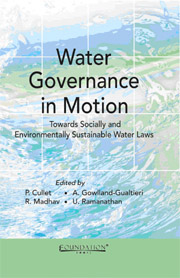Book contents
- Frontmatter
- Contents
- Acknowledgments
- Contributor Biographies
- Introduction
- I Water Law, Policy and Institutional Reforms in India
- II Ongoing Irrigation and Ground Water Reforms in India
- III Perspectives on Privatisation
- 8 Tirupur Water Supply and Sanitation Project: A Revolution in Water Resource Management?
- 9 The World Bank's Influence on Water Privatisation in Argentina: The Experience of the City of Buenos Aires
- 10 The Linkages between Access to Water and Water Scarcity with International Investment Law and The WTO Regime
- 11 More Drops for Hyderabad City, Less Crops for Farmers: Water Institutions and Reallocation in Andhra Pradesh
- IV Environment and Human Rights
- V Comparative Perspectives on Reforms
- Bibliography
8 - Tirupur Water Supply and Sanitation Project: A Revolution in Water Resource Management?
from III - Perspectives on Privatisation
Published online by Cambridge University Press: 26 October 2011
- Frontmatter
- Contents
- Acknowledgments
- Contributor Biographies
- Introduction
- I Water Law, Policy and Institutional Reforms in India
- II Ongoing Irrigation and Ground Water Reforms in India
- III Perspectives on Privatisation
- 8 Tirupur Water Supply and Sanitation Project: A Revolution in Water Resource Management?
- 9 The World Bank's Influence on Water Privatisation in Argentina: The Experience of the City of Buenos Aires
- 10 The Linkages between Access to Water and Water Scarcity with International Investment Law and The WTO Regime
- 11 More Drops for Hyderabad City, Less Crops for Farmers: Water Institutions and Reallocation in Andhra Pradesh
- IV Environment and Human Rights
- V Comparative Perspectives on Reforms
- Bibliography
Summary
Introduction
The Tirupur Water Supply and Sanitation Project (henceforth the Project) typifies an incongruity in water resource management and prioritisation. It is paradoxical that the textile industry which has over-extracted and polluted the water bodies in and around Tirupur for a decade now, has been given first priority in designing a water supply scheme. Also ironically, the scheme draws clean raw water (nearly 125 million litres per day) from a river source, but does not conceive of a design for the discharge and treatment of the same. Pollution caused due to industrial waste continues to plague Tirupur, even as state of the art technology is being installed to extract and transport water from distant sources. The scheme, in effect, has a direct bearing on the efforts to ensure recycling of waste water and ‘zero effluents discharge’ and in turn, the broader agenda of sustainable water management and conservation.
The Tirupur Water Supply and Sewerage Project has many firsts to its credit – ‘it is the first project to be structured on a commercial format; the first project-specific public limited company for water and sewerage with equity participation of major beneficiaries; first concession by a state government to a public limited company to draw raw water for domestic and industrial uses and to collect revenues; the first index-based user charges and direct cost recovery for urban environmental services; construction, operations and maintenance of infrastructure and related services by experienced domestic and international operators’.
- Type
- Chapter
- Information
- Water Governance in MotionTowards Socially and Environmentally Sustainable Water Laws, pp. 201 - 229Publisher: Foundation BooksPrint publication year: 2010



